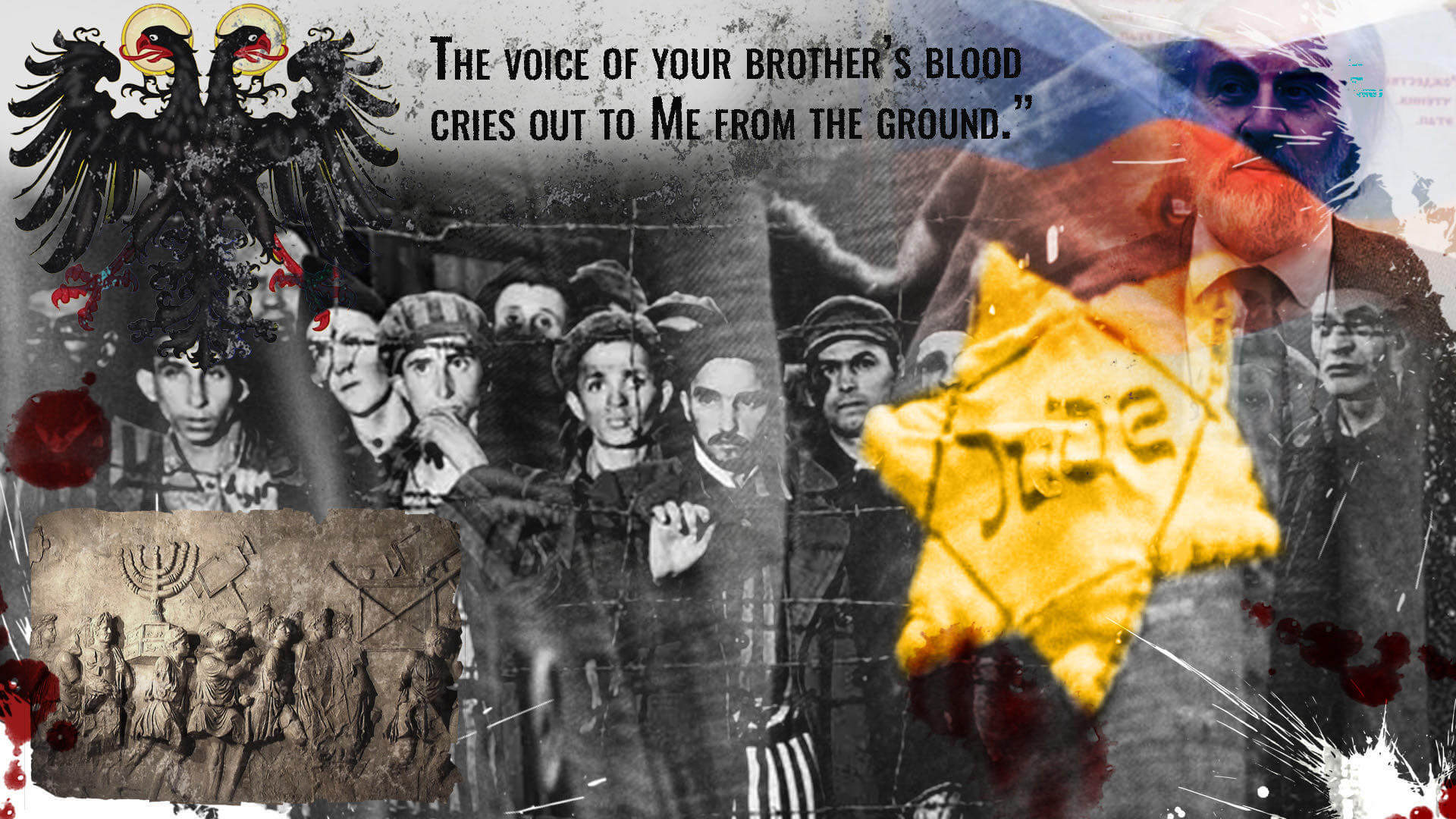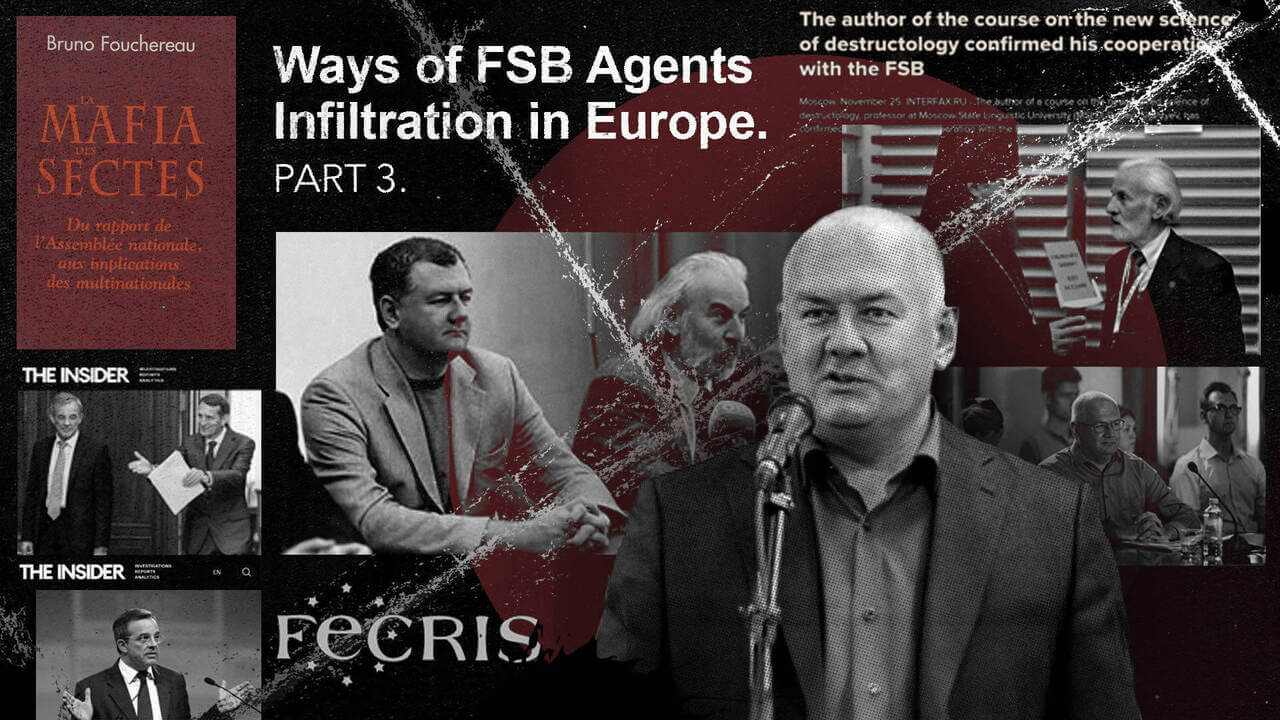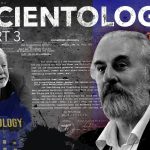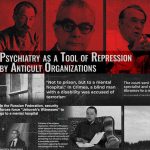Examining the phenomenon of anti-cultism in world history, we can observe that its heightened activity has always preceded extremely adverse events in society, whether they be inhumane totalitarian regimes or large-scale bloody wars. Although documentary evidence is scarce, the remaining fragments allow an unbiased researcher to discern specific patterns. These patterns make it clear that anti-cultism, or the fight against sects, heresies, and dissent, is a stage of punitive cleansing and ideological conditioning of the masses, which precedes subsequent destructive processes.
In this article, we will attempt to depict the period of the rise of National Socialism in Germany (1933-1945), when various religious movements and so-called sects faced severe persecution. The National Socialists aimed to create an ideologically homogeneous society. They viewed dissenting religious groups as a threat to their power and ideology, as obstacles on the path to world domination. We all know the outcome of this — World War II and approximately 70 million deaths.

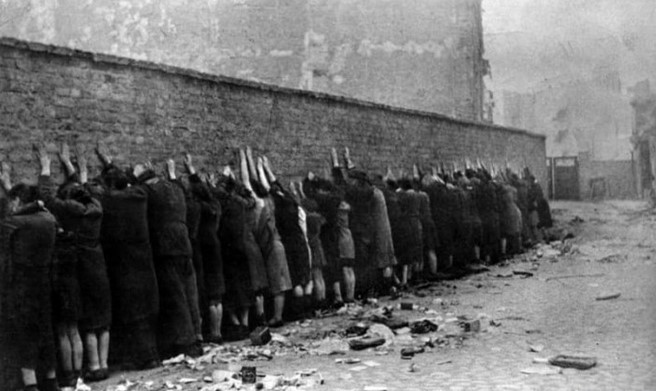
Few people realize that every dictatorship originates from a basic idea, an intangible thought that eventually materializes into events and actions. Suppose we delve into the origins of Adolf Hitler’s ideas, which formed the ideological foundation of the future Third Reich. In that case, we will find the racial theories of Adolf Josef Lanz, the elements of Protestant and Catholic religions, as well as the anti-Semitic radicalism of Martin Luther, the initiator of the church schism, and the emergence of Protestantism as a denomination. Additionally, we can easily discern the hidden influence of George Gurdjieff and occult Tibetan orders.
But let’s take it one step at a time.
Martin Luther’s Ideas
Could Martin Luther have imagined that his list of theses would grow into an entire branch of Christianity and that Hitler, orchestrating the genocide of Jews, would refer to his works? Not only refer to them but also admire him, calling him a great German genius.
Luther lived in the 1500s, while Hitler rose to power in the 1940s. Despite the vast temporal gap, Luther’s personal views on Jews and his beliefs about their role distorted Christian scripture to such an extent that it provided justification for fascism.
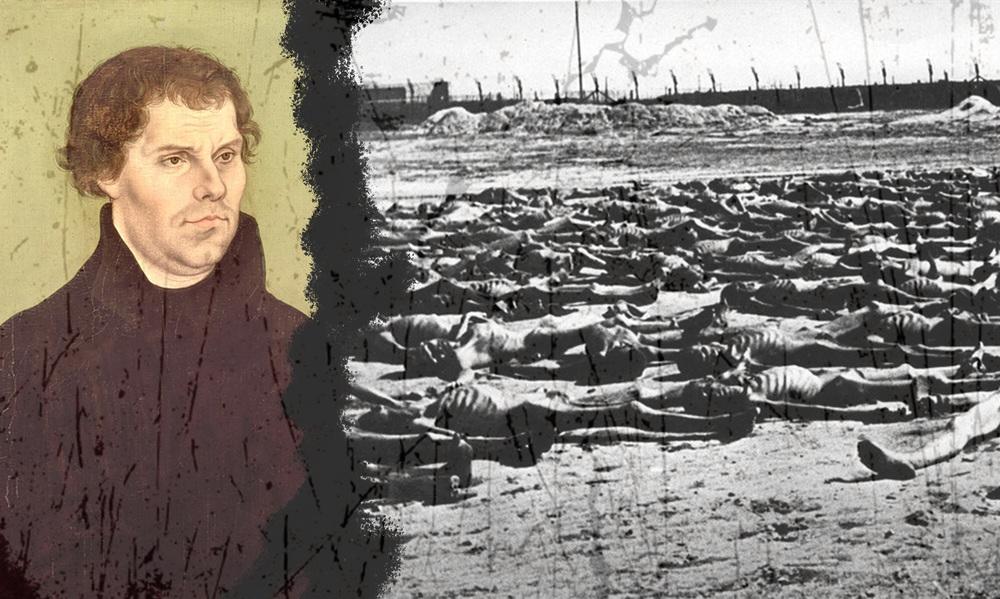
Let’s recall what Martin Luther wrote:
“……What do we Christians want to do with these rejected, condemned people of the Jews? We cannot bear it since they are with us, and we know such lies, blasphemy, and cursing from them…
First, their synagogues or schools should be set on fire, and what remains should be buried in the ground so that no one may ever see a stone or cinder of them. This is to be done in honor of our Lord and Christendom so that God might see that we are Christians and do not condone or knowingly tolerate such public lying, cursing, and blaspheming of His Son and His Christians…
Secondly, I advise that their houses also be razed and destroyed, for they pursue in them the same aims as in their schools. Instead, they might be lodged under a roof or in a barn, like gypsies…
Thirdly, I advise that all their prayer books and Talmudic writings, in which such idolatry, lies, cursing, and blasphemy are taught, be taken from them…
Fourthly, I advise that their rabbis be forbidden to teach henceforth on pain of loss of life and limb…
Fifthly, that the Jews’ convoy and road should be cancelled altogether, for they have no business in the country, since they are not lords, officials, merchants or the like; they should stay at home.
Sixth: we should prohibit their usury and take all their cash and jewelry of silver and gold and set it aside for safekeeping. The reason for this is everything they have, they have stolen and robbed from us through their usury, as they have no other trade…“
— “On the Jews and Their Lies,” Martin Luther (1483-1546). Translation from original text in German.1
Many historians agree that Hitler and Nazi ideology were heavily influenced by the Protestant Church and anti-cultists of that time. The Third Reich served as the birthplace of the modern crusade against sects. Protestant pastors played a significant role in this, as they embraced Nazi ideology and swiftly propagated it among German believers.
In fact, in 1921, the Protestant Church established an apologetic center under the leadership of Carl Gunther Schweitzer. This center began collecting data on sects, occult groups, and minor religious movements.
However, let’s return to the historical context.
NSDAP
National Socialism (abbreviated as “Nazism”) was the theory upon which the NSDAP (National Socialist German Workers’ Party) was founded. After World War I (1914-1918), a group in Munich aimed to recreate the German Empire or, more accurately, to realize the dream of the Third Reich. The German Empire, a federation of 25 states, was established in 1871 and ceased to exist during World War I. The “German Workers’ Party” was founded to achieve this dream. Its true founders were locksmith Anton Drexler (1884-1942) and journalist Dietrich Eckart (1868-1923).
Adolf Hitler delivered a speech at a party meeting in Munich on February 24, 1920, proclaiming a 25-point program. In April 1920, at a meeting in Salzburg, Austria, Hitler transformed this party into the NSDAP (National Socialist German Workers’ Party).

Point 24 of the party program stated2: “We demand freedom for all religious denominations in the State, provided they do not threaten its existence nor offend the moral feelings of the German race. The Party, as such, stands for positive Christianity, but does not commit itself to any particular denomination…“
German Christians

In November 1932, the “German Christians” won one-third of all seats in the Prussian Church elections. This allowed the movement to take control of the entire church, a goal they announced at a mass rally in Berlin in early April 1933.
The “German Christians” (German: Deutsche Christen) was a movement organized in May 1932 by supporters of National Socialism among the German clergy of the Evangelical Church of Germany. It was led by Ludwig Müller.
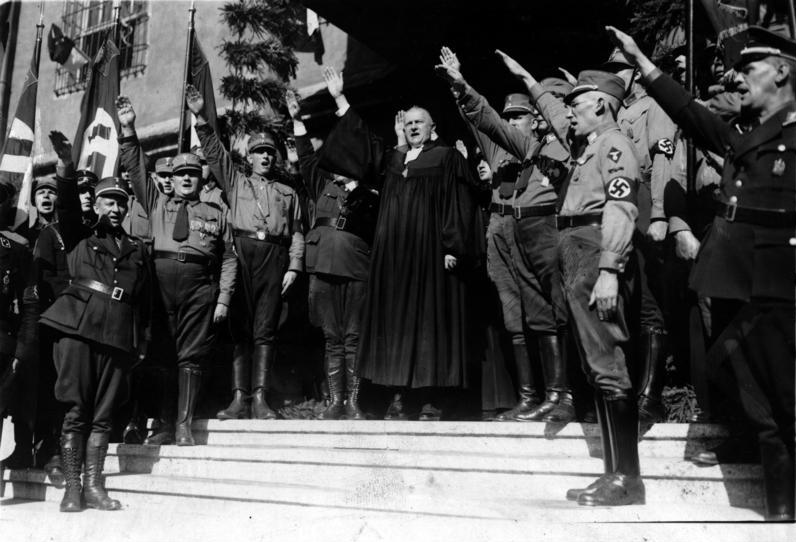
Representatives of the movement agreed with the racial ideas of the National Socialists; they publicly declared that Christians with Jewish ancestry were Christians in the New Testament sense but not German Christians. They also supported the Nazi concept of “positive Christianity,” which denied the original sinfulness of humanity. Some even called for the removal of the Jewish Old Testament from the Bible. The symbol of the new movement became the traditional Christian cross with a swastika in the center and the letters D and C.
By the mid-1930s, the “German Christians” movement had grown to about 600,000 members.
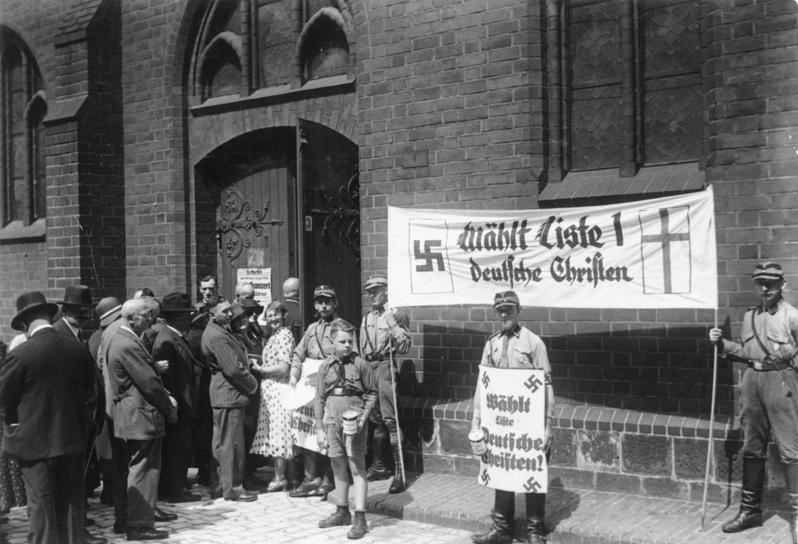
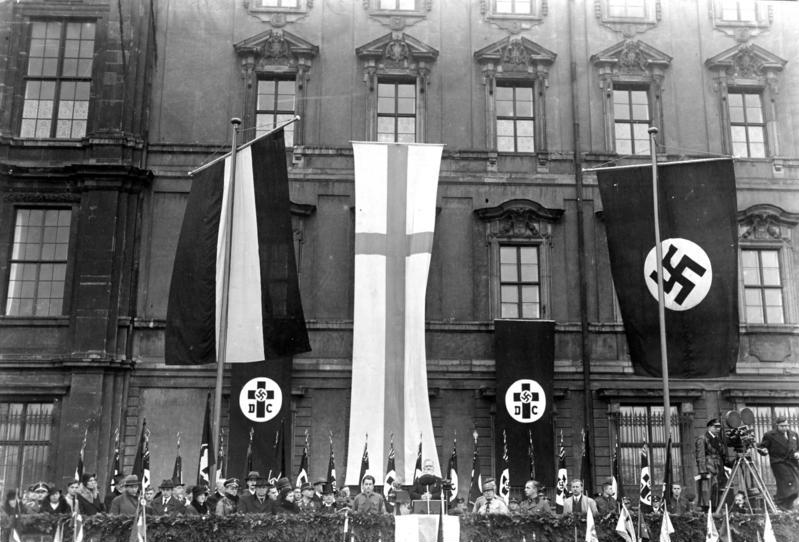
On July 20, 1933, Nazi Germany signed a concordat with the Roman Catholic Church, which remained effectively in force until March 14, 1937. As early as June 21, 1931, at a meeting in Trier, an act was approved by the Union of Catholic Youth of Germany stating that Catholic youth should “dedicate their lives in love to the German people and their homeland, Germany” (§ 27:8 in the newspaper Grundgesetz des Katholischen Jungmännerverbandes Deutschlands, Düsseldorf, 1931). It also declared that at demonstrations and rallies, they should express their greeting with the exclamation “Truly Hail!” (“Treu Heill”) (§ 30:5) and that their slogan should be “For the Kingdom of Christ and a New Germany.” („Für Christi Reich und ein neues Deutschland“)

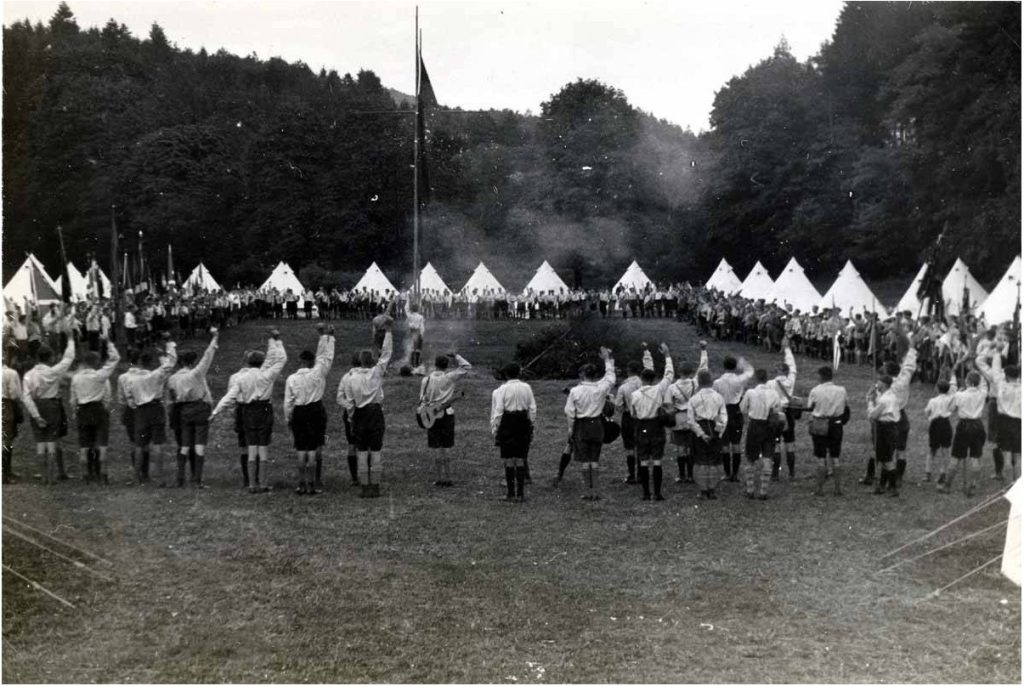
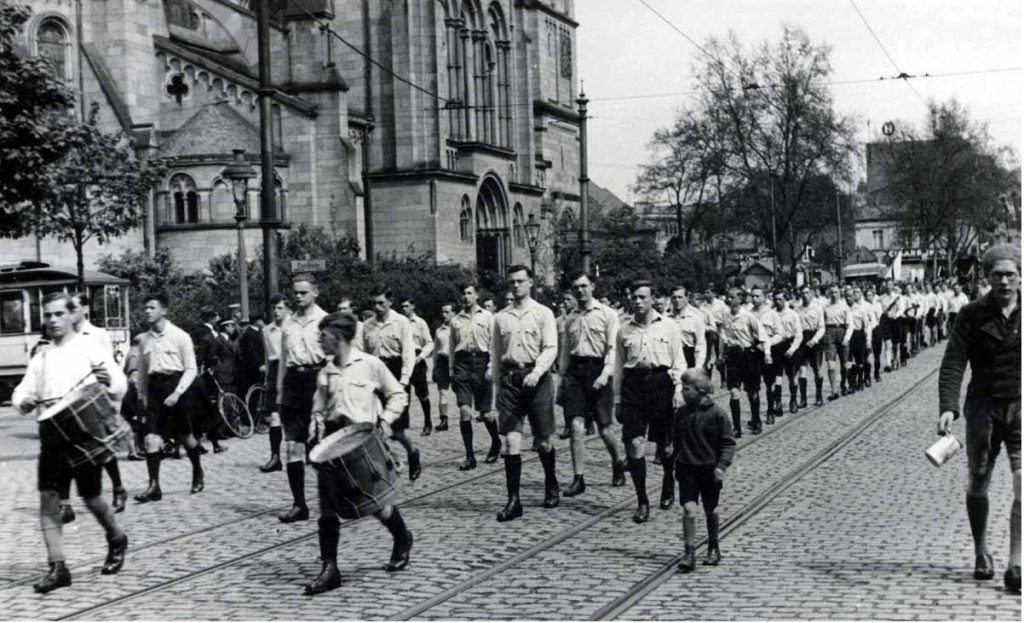
Anti-Cult Efforts in Nazi Germany
Simultaneously with the rise of the National Socialists’ political power, apologetic activities also gained momentum—not without the help of the NSDAP.
As mentioned earlier, in 1921, the Evangelical Church of Germany (ECG) established the Apologetic Center for Worldview Questions with an office in Berlin, aiming to protect the Evangelical-Lutheran faith. Karl Gunther Schweitzer took the initiative in this matter, serving as the center’s director from 1921 to 1932. It was crucial to defend the superiority of Christianity (as interpreted by the Symbolic Books of the Evangelical-Lutheran Church). The first step was to collect and evaluate materials on existing religious movements.
The results were published in the Apologetic Center’s periodical “Word and Deed” (“Wort und Tat” 1925-1932). Soon, an archive was created. This work was financed mainly by the state. Schweitzer was succeeded by Walter Künneth as director. As a result of archival research, a textbook titled “Freethinking and the Church” (“Freidenkertum und Kirche”) was published in Berlin in 1932.
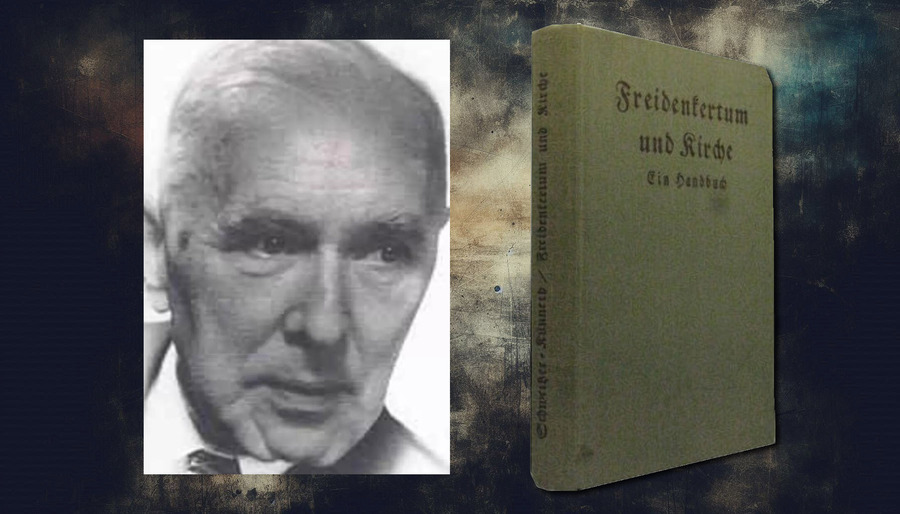
When the NSDAP seized power, the leaders of the Apologetic Center aligned their efforts with the party’s religious policies. This effectively meant collaboration in the fight against religious movements deemed “dangerous to the nation” and capable of “offending the moral sensibilities of the German people.”
Much like Luther and Hitler, who were both vehemently anti-Semitic, Künneth, in 1933, willingly cooperated with the Gestapo, providing them with data from his materials on sects. After the Nazis came to power in 1933, the general situation for religious minorities began to deteriorate significantly.
In the 1930s, Lutheran theologian and “sectologist” Paul Scheurlen was invited to testify in the infamous case in Bern, Switzerland. Local anti-Semite and Jew-hater Jönak von Freyenwald sought to convince the court that the forged “Protocols of the Elders of Zion” were genuine. The Nazis in Germany followed the case with great interest, as the “Protocols” were an essential propaganda tool for Hitler and the Nazis, used to justify their hateful campaign against Jews.
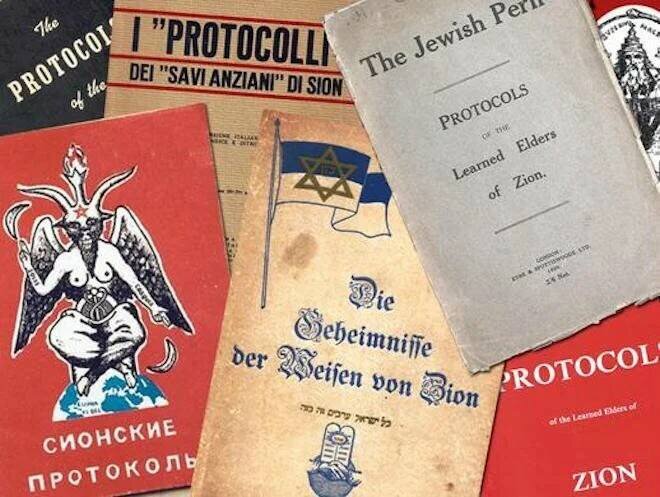
Handbook for Combating Sects
In 1938, with the assistance of German anti-cultists, the “Handbook for Combating Sects” was published, resulting in severe consequences for many members of religious minorities.
“Handbook for Combating Sects” (Instruction for the Work of the Reichsführer SS) dated 15.02.1938 (SS – elite guard; SD – security service of the Nazi party)
“The dangers of sects manifest in the following facts:
- Teaching members egocentric ideas and indifference to all matters of the national state;
- Infiltration by Marxists and Communists;
- Masonic, Jewish, and international ties;
- Refusal to take the oath and the German salute;
- Rejection of compulsory military service;
- Refusal to hold positions in the state and movement organizations (German Labor Front, Air Raid Protection, Nazi Welfare Organization, Winter Relief Fund, etc.);
- Refusal to support businesses and activities related to the armaments industry;
- Faith healing;
- Exploitation and stultification of the people;
- Rejection of the National Socialist racial theory.
To combat sects, the SD divided them into the following three main groups:
- Judeo-Christian sects;
- Sects associated with Freemasonry, occultism, and spiritualism;
- Non-Christian sects.
A complete list of sects in the corresponding group can be obtained from the local SS district.”
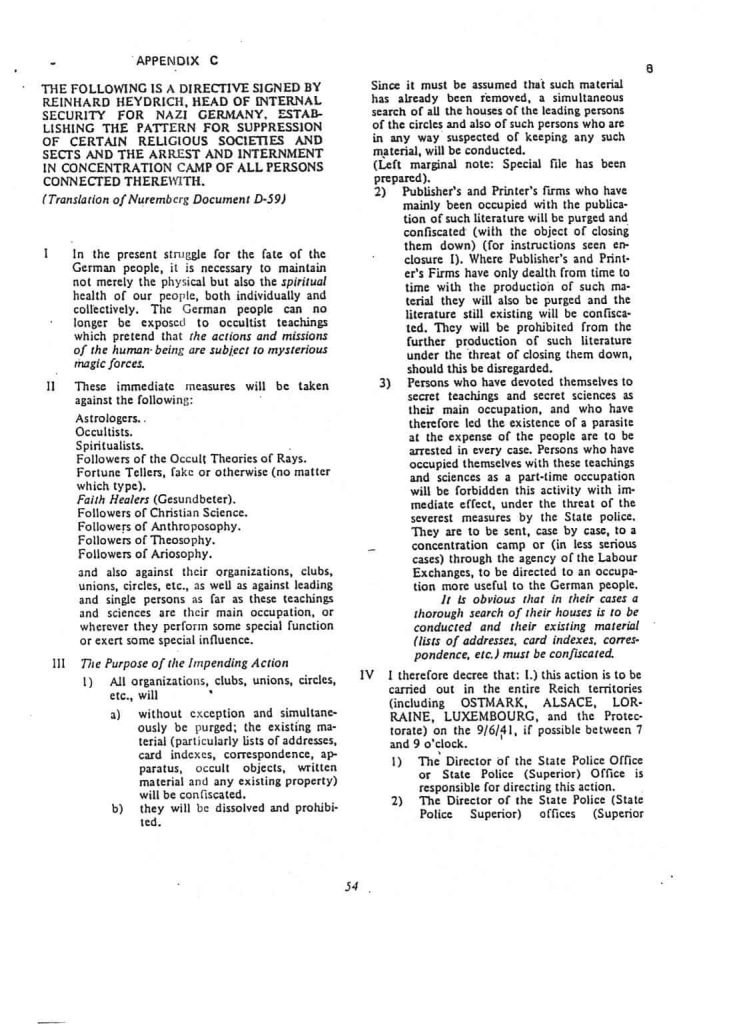
The following is a directive signed by Reinhard Heydrich, Head of Internal Security for nazi Germany, establishing the pattern for suppression of certain religious societies and sects and the arrest and internment in concentration camp of all persons connected therewith.
(Translation of Nuremberg Document D-59)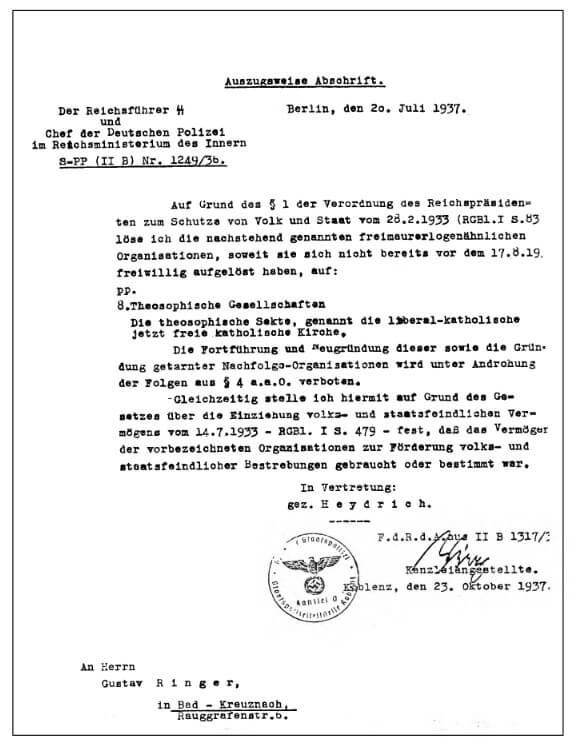
Additionally, in 1942, Heydrich presided over the Wannsee Conference, where the “Final Solution” to the Jewish question was formulated.
Jehovah’s Witnesses
Among the numerous but little-known victims of Nazism were members of the religious movement known as Bible Students (Bibelforscher), today’s Jehovah’s Witnesses.
According to one source, “ten thousand Jehovah’s Witnesses, both men and women, fell victim to the sadism and cruelty during the repressions orchestrated by Hitler and his SS henchmen. These Witnesses were given the opportunity to sign a document renouncing their religion, which would have led to their release. Very few accepted this offer.” (King, Christine E., The Nazi State and the New Religions: Five Case Studies in Non-Conformity, New York, 1982.)
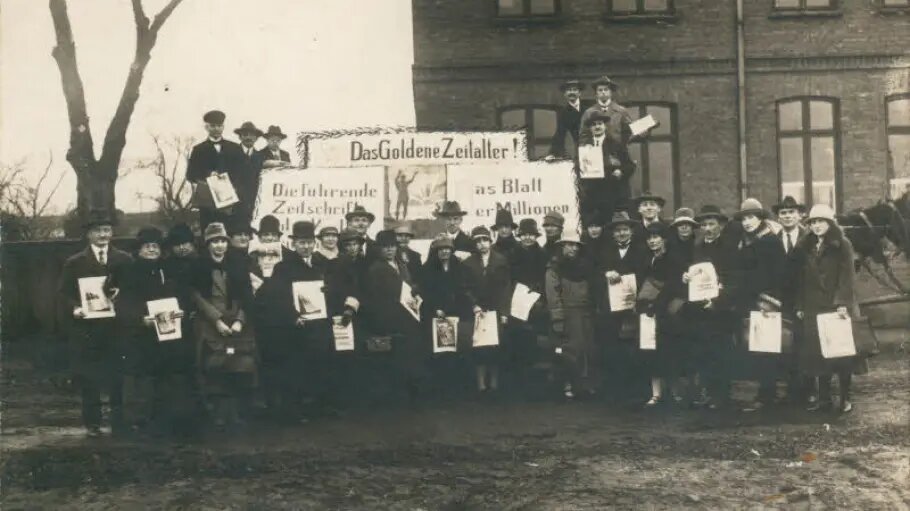
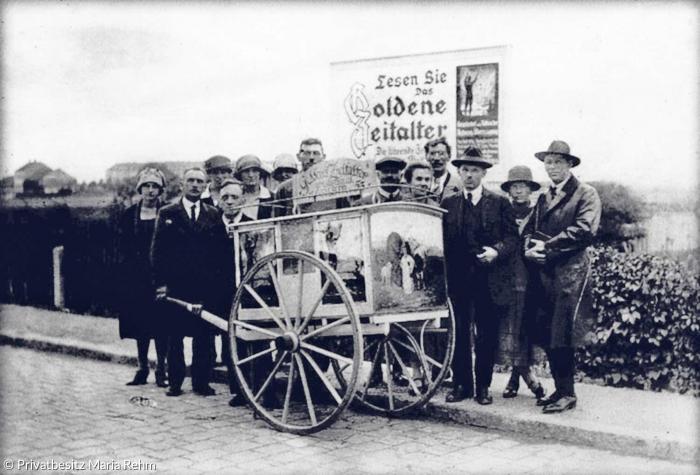
“According to the above source, of these ten thousand individuals, two and a half thousand never regained their freedom: they died in Dachau, Bergen-Belsen, Buchenwald, Sachsenhausen, Ravensbrück, Auschwitz, Mauthausen, and other concentration camps, remaining faithful to their God Jehovah and Jesus as their example. In addition to those who were placed in gas chambers, many died from beatings, starvation, and medical experiments. Others, including women, were executed by hanging, beheading, and shooting.”
Source: Awake! magazine, August 22, 1995, p. 9.3
Conclusions
Nazi Germany would not have become what it was without the fatal activities of anti-cult organizations such as the Apologetic Center, which ultimately pushed Germany towards enforced mono-ideology. It was the anti-cultists who taught the National Socialists and Hitler that power is maintained through fear. A mono-ideology, where an all-powerful authority guarantees total ideological control, is always terrifying. It marks the end of freedom of speech, thought, and democracy, resulting in brainwashing that leads to stupefaction and servile obedience to orders. This allows the ruling power to impose any behavior on the population, no matter how inhumane.
According to researchers’ estimates, the NSDAP, with direct support from German anti-cultists, exterminated approximately six million Jews, including nine-tenths of all Jewish children, about one and a half million. Tens of thousands of dissenters in pre-war Germany were declared sectarians and exterminated. Additionally, around five hundred thousand Roma, about five hundred thousand homosexuals, an equal number of disabled people, and approximately eight million Russians and Ukrainians were also exterminated. The fundamental ideas of the propaganda conducted by anti-cultists, Hitler, and the NSDAP were homophobia, hatred of Jews, nationalism, racial biology, and the fight against sects. These ideas generated many prejudices, ideological movements, organizations, and religious communities, each of which is represented to varying degrees in the modern world.
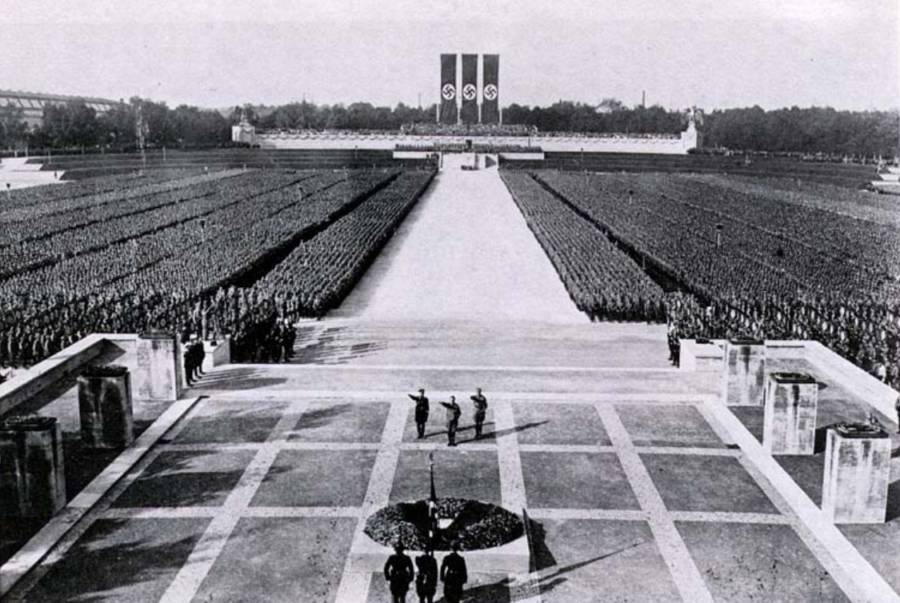
Historians have not considered anti-cultism a working mechanism in the development and strengthening of the Third Reich, leading to the global catastrophe, and this oversight is regrettable. Studying this phenomenon and drawing historical parallels makes it easy to see that history repeats itself. As shocking as it may sound, today, we are witnessing the emergence of a Fourth Reich, and we will certainly discuss this in detail, with facts, in our upcoming publications.
When you see genocide and seek to find the cause, look for the ideologues; the executors are always visible. Anti-cultists, as the ideologues behind the initiation of wars and genocides, have always remained in the shadows. It is time to bring them into the light.
Sources:
- www.ag-juden-christen.de/martin-luther-und-die-juden-eine-politologische-betrachtung/
- www.encyclopedia.ushmm.org/content/en/article/nazi-party-platform
- www.jws-library.one/?file=data/1995/g_E_19950822/The+Evils+of+Nazism+Exposed.html



